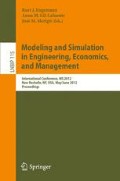Abstract
This paper examines why a financial entity’s solvency capital estimation might be underestimated if the total amount required is obtained directly from a risk measurement. Using Monte Carlo simulation we show that, in some instances, a common risk measure such as Value-at-Risk is not subadditive when certain dependence structures are considered. Higher risk evaluations are obtained for independence between random variables than those obtained in the case of comonotonicity. The paper stresses, therefore, the relationship between dependence structures and capital estimation.
Access this chapter
Tax calculation will be finalised at checkout
Purchases are for personal use only
Preview
Unable to display preview. Download preview PDF.
References
Artzner, P., Delbaen, F., Eber, J.M., Heath, D.: Coherent Measures of Risk. Mathematical Finance 9(3), 203–228 (1999)
Jorion, P.: Value at Risk. The new Benchmark for measuring financial risks. McGraw Hill, NY (2007)
Fang, K.T., Kotz, S., Ng, K.W.: Symmetric Multivariate and Related distributions. Chapman and Hall, London (1990)
Embrechts, P., McNeil, A., Straumann, D.: Value at Risk and Beyond. Correlation and Dependency in Risk Management: properties and pitfalls. Cambridge University press, Cambridge (2002)
Embrechts, P., McNeil, A., Frey, R.: Quantitative Risk Management. Concepts, Techniques and Tools. Princeton University Press, Princeton (2005)
Embrechts, P., Höing, A., Juri, A.: Using copulae to bound the value at risk for functions of dependent risks. Finance Stochastic 7(2), 145–167 (2003)
CEIOPS, 5th Quantitative Impact Study - Technical Specifications, https://eiopa.europa.eu/consultations/qis/index.html
Nelsen, R.B.: An introduction to Copulas. Springer, USA (2006)
Joe, H.: Multivariate Models and Dependence Concepts. Chapman & Hall, UK (1997)
Guillén, M., Prieto, F., Sarabia, J.M.: Modeling losses and locating the tail with de Pareto Positive Stable distribution. Insurance: Mathematics and Economics 49(3), 454–461 (2011)
Sarabia, J.M., Prieto, F., Gómez-Déniz, E.: Análisis de riesgos con la distribución Pareto estable positiva. In: Cuadernos de la Fundación, vol. 136, pp. 191–205. Fundación Mapfre, Madrid (2009)
Author information
Authors and Affiliations
Editor information
Editors and Affiliations
Rights and permissions
Copyright information
© 2012 Springer-Verlag Berlin Heidelberg
About this paper
Cite this paper
Ferri, A., Guillén, M., Bermúdez, L. (2012). Solvency Capital Estimation and Risk Measures. In: Engemann, K.J., Gil-Lafuente, A.M., Merigó, J.M. (eds) Modeling and Simulation in Engineering, Economics and Management. MS 2012. Lecture Notes in Business Information Processing, vol 115. Springer, Berlin, Heidelberg. https://doi.org/10.1007/978-3-642-30433-0_5
Download citation
DOI: https://doi.org/10.1007/978-3-642-30433-0_5
Publisher Name: Springer, Berlin, Heidelberg
Print ISBN: 978-3-642-30432-3
Online ISBN: 978-3-642-30433-0
eBook Packages: Computer ScienceComputer Science (R0)

